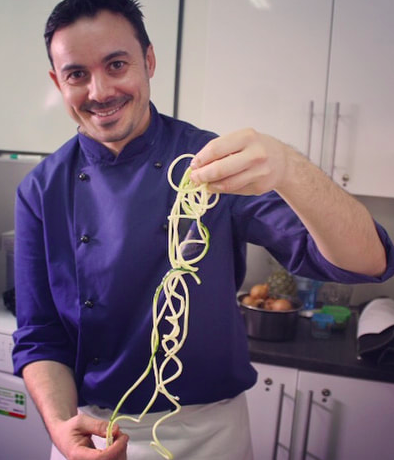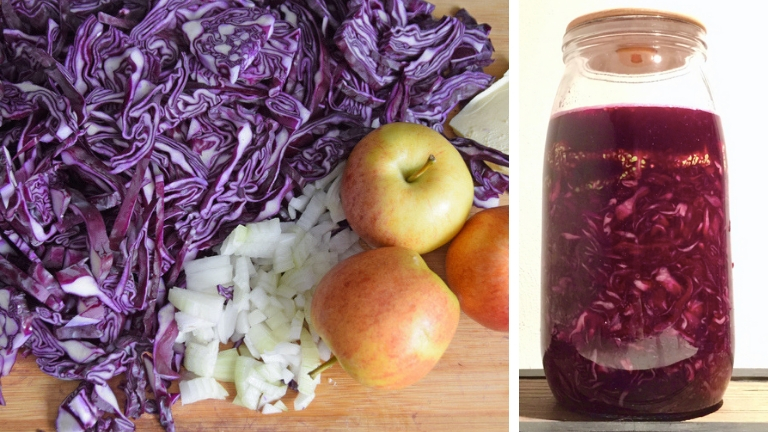Michelin star-trained chef, nutritional therapist and naturopath Olivier Sanchez shares one of his top-secret recipes with Healthista that will boost your gut’s friendly bacteria
Fermenting… Fermenting… Fermenting…How scary, right? But it’s actually much easier than you might think to make your own fermented sauerkraut.
Actually this recipe is technically called Blaukraut because it uses red instead of white cabbage and it has a deep purple colour from the beetroot hence the blau in the name (‘blau’ in German means blue).
Olivier recommends adding a few extra chillies and jalapenos for a dynamite combination.
Prep time: 25 minutes
Fermenting time: 7–14 days
Ingredients
- 2 medium Beetroots (grated)
- 2 heads Red cabbage (sliced)
- 2 crisp tart Apples (Cameo, Cortland, Granny Smith)
- 1 tbsp Caraway Seeds
- 1 tsp Sea Salt (preferably Salt Flower or “Fleur de Sel” in French)
- 1 medium Red Onion (thinly sliced)
- 1 tsp Cloves (about 4–6, optional)
- Chillies and jalapenos to taste (optional)
Method
1. Choose the red cabbage head with the deepest red. Avoid plastic covered heads, those that look old or wilted or with the leaves starting to separate from the stem. A dull colour is often an indication that the cabbage is no longer fresh and its nutritional value may also not be at its peak.
2. Start by removing the coarse outer leaves, rinse a few unblemished leaves and set them aside. Rinse the rest of the cabbage, cut into four wedges with a sharp knife and remove the hard core. Slice the quarters as thinly as you can or use a mandolin if you have one. Transfer the shredded cabbage to a large kitchen bowl.
3. Cut the apples into four wedges, remove the core, and thinly slice each quarter. Add the sliced apples and the remaining ingredients except the salt into the bowl containing the cabbage.
4. Add half the salt and massage it into the leaves, then taste. Only add the remaining salt if necessary. It should taste slightly salty but not overwhelmingly so. If it tastes good now, it will be amazing in taste once fermented.
5. As you massage the cabbage leaves, they will start to glisten and release liquid. This is normal, you are essentially breaking the cell walls of the leaves. You want the natural juices of the cabbage to come out. If there’s not much juice coming out, you may need to leave the bowl to rest for a little while. Cover the bowl with a wet cloth and let to stand at room temperature for an hour and massage again.
6. Wash your hands thoroughly but do not use antibacterial soap, it will kill the friendly bacteria required for the fermentation process. From this stage onwards. It’s also important to avoid using metal utensils. The bacteria don’t like it and may die. Use preferably silicone, plastic or glass bowls and tools.
7. Decant the cabbage, a handful at a time, into a large jar (about 3 litres), pressing down each time with your fist or a tamper. This is to make sure you remove any air pockets (that will supply oxygen to the bad kind of bacteria).
8. The liquid (or brine) should now cover the cabbage as more fluid is released as you keep pressing down. Bubbles may form at the top of the brine and this is normal, it is the oxygen escaping. Repeat until the jar is nearly full but leave 5–8cm from the top of the jar. If you prefer to use (or lucky to have) a water-sealed fermentation crock pot, then you should leave about 10 cm from the top.
9. Top the cabbage-beetroot mix with one or two outer leaves you have set aside (several if you are using a crock pot and cover with a plate turned upside-down depending on the shape of your crock).
10. When using a jar, you may not need a “follower”, which is anything used to keep the content of the jar submerged in brine like a silicon mat or a mesh (such as that found in a dehydrator or used in pastry making. If necessary, you may have to cut it to shape).
11. Use a weight to keep the leaves (or plate or follower) submerged. You can use a glass or the terracotta weight that is often supplied with fermenting jars. If you don’t have any, you can actually use a strong sealed water-filled freezer bag or even a small jar that fits inside your fermentation vessel. If you are using a crock, then a large water-filled freezer bag will work perfectly well or even a larger water-filled jar. Anything that ensures the brine completely covers the cabbage will work. Set aside away from sunlight, inside a kitchen cupboard for example.
12. Check daily that the blaukraut is well under the brine. Press down with your fist or a tamper to bring the brine back to the surface if necessary. This will remove any air pockets that may have formed or sneakily gotten in. Remember that it is imporantant to keep an anaerobic environment inside the jar so that the bad bacteria can’t multiply.
13. Taste your Blaukraut from day 7. The cabbage should have softened but yet remained somewhat crunchy, and it should be pleasant, like tasting pickles. It should not be strong or acid like vinegar.
14. When ready, or to your taste, ladle the blaukraut into smaller jars, press down and top them up with the remaining brine. Screw and tighten the lid and store in your fridge. It should keep for a year. That is if you can manage to behave yourself for that long.

For more information, recipes and nutritional health tips, visit his blog and professional website, Nutrunity and Exquisite Private Chef. Olivier can also be found on Instagram @exquisiteprivatechef
Related Healthista content
Could a fermented milk drink cure your depression and IBS?
What are the benefits of beetroot powder?
Fermented foods – are they worth the hype?
Fermenting foods at home: A step by step guide
60 second smoothie for energy – Raspberry & Beetroot Zinger
What’s REALLY going on with your your gut health?
10 everyday lifestyle habits that ruin your gut health
Click here to enter our competition for your chance to win an overnight spa stay worth £300
Wellbeing trends for 2019: apply here to attend Healthista’s first wellbeing trends of the future event
Like this article? Sign up to our newsletter to get more articles like this delivered straight to your inbox.






















































